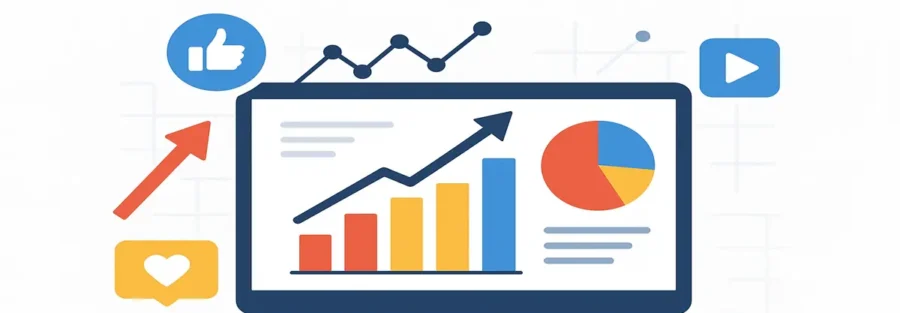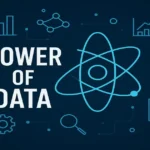Introduction
In today’s digital world, every business, whether small or large, is using social media to reach its customers. However, simply posting or creating videos is not enough. The real game is to understand the data and use it properly. This is where social media analytics comes in.
It is a process that tells us how successful our social media activities are. Which posts people are liking, which ones are being ignored, and which content is bringing more engagement—it gives us the answer to all this.
In simple words, it is a tool that turns the data scattered in the sea of social media into understandable and useful information. When you use this information effectively, your content strategy becomes stronger, you save time and money, and most importantly, you get to know the pulse of your customers.
What is social media analytics?
Social media today is not just a means of entertainment, but it has become a platform where people express their opinions, brands build their identity and businesses connect with their customers. But when so many activities happen simultaneously, it becomes difficult to understand what is really making an impact and what is not.
This is where Social Media Analytics comes in.
In simple words, social media analytics is the process by which data (such as likes, comments, shares, followers, clicks, and views) collected from social media platforms is collected and analyzed in depth. Its purpose is to know how people are engaging with your brand or content and what their interests are.
Suppose you posted a post on Instagram. Now, just counting the likes will not give you much information. But analytics will tell you—
How many people did our post reach?
Why Social Media Analytics Matters?
Today, social media is a world full of opportunities for everyone. People spend time here, brands build their identity, and businesses connect directly with their customers. But the question is, is just being present enough? The answer is no. The real difference is when you understand how much impact your social media efforts have on people. This is what social media analytics does.
- It tells you if your social media efforts are really working.
- Helps you make informed decisions based on data and facts, not guesswork.
- Lets you understand what kind of content (videos, reels, photos, or blogs) people are liking the most.
- Helps save time and money as you stick to the strategies that are working.
- Helps you know the interests, age, location, and active times of customers.
- The real return (ROI) of your ads and campaigns is clearly visible.
- Strengthens your position compared to competitors and gives you an edge over them.
- Helps to build better engagement with customers and retain them for a longer time.
Key features of Social Media Analytics
- Data Tracking
- It lets you track every minute detail about every post, ad, and campaign—how many likes it got, how many people shared it, how many clicked on the link, and how many followed it.
- Audience Insights
- Analytics tells you who your audience is—what their age, gender, location, and interests are. This allows you to tailor your content to their needs and preferences.
- Engagement Measurement
- Just posting on social media is not enough. The real power is in knowing how much people are engaging with your content. Analytics gives you a clear engagement rate.
- Real-Time Monitoring
- With its help, you can immediately see how fast your content is spreading. For example, if a post is going viral, you will know it immediately and you can take full advantage of it.
- Content Performance Analysis
- It shows which type of content—video, reels, photos, stories or blogs—is working the most and which audience is engaging less with.
- Competitor Analysis
- You can understand not only your performance but also the strategy of competitors. This feature shows you what kind of content your competitors are putting up and how people are reacting to it.
- ROI Tracking
- The most important feature of social media analytics is that it gives you an account of the money spent on your ads and campaigns. That is, how much benefit you got from your investment and what improvements are needed.
- Reporting & Visualization
- Analytics converts complex data into easy charts, graphs, and reports so that anyone can easily understand and make decisions.
- Trend Identification
- It also shows you which trends are currently trending and which topics your audience is responding to the most.
- Predictive Analysis
- Advanced tools can even predict what kind of content will be more successful in the future. This allows you to prepare in advance.
Case studies: Social Media Analytics success story
1. Zomato
Zomato deeply analyzed user reactions on their Twitter and Instagram handles. Using social media, they understood that people respond more to funny and real-time content. The result—brand engagement increased manifold.
2. Nike
Nike analyzed data on Facebook Ads and Instagram Reels and found that motivational videos in their “Just Do It” campaign were going viral the most. Based on this data, they changed their content strategy for the entire year and increased sales.
3. Swiggy
Swiggy analyzed delivery-related complaints and positive feedback on social media. This helped them gauge customer preferences, and they gave offers and discounts accordingly.
4. Amul
Amul’s social media strategy is a great example in India. Amul’s topical ads (which are based on current events) are so successful because they use continuous analytics to understand what people are talking about the most.
This data-driven strategy has made Amul an “evergreen and trendy brand” on social media.
These case studies make it clear that social media is important not just for big brands but for every business that wants to understand its audience better and grow in the digital world.
How to use Social Media Analytics?
- Choose the right tool – Tools like Google Analytics, Hootsuite, Buffer, and Sprout Social are popular.
- Set goals – Do you want to increase followers, sales, or brand awareness?
- Collect data – Check insights and reports regularly.
- Create reports – Create data reports on a weekly or monthly basis.
- Test and improve – Change posts that are not working and try new methods.
- Competitor Watch – Track your competitors’ strategies as well.
- Create an actionable strategy – Just looking at data will not do anything; take steps based on it.
- Measure ROI – See how much money you spend on your ads and campaigns.
Conclusion
Social media today is not just a means of entertainment, but it has become a world for every individual and every business where the path of recognition, trust and success is paved. If we limit ourselves to just posting or making videos, it will be an incomplete effort. The real power comes when we start understanding the impact of every effort we make, how people are responding, and what value they are getting from our message. This is what social media does.
It is not just a process of looking at numbers. It shows us the real picture of our audience – who they are, what they want, what they connect wit,h and what they ignore. When we know when our audience is most active or what content attracts them again and again, then we can change our strategy accordingly. This not only saves time and money but also puts our efforts in the right direction.
FAQ
Q1. What is social media analytics in simple words?
Social media analytics is the process of collecting and analyzing data from platforms like Facebook, Instagram, Twitter, and LinkedIn to understand audience behavior, engagement, and campaign performance.
Q2. Why is social media analytics important for businesses?
It helps businesses make data-driven decisions, improve content strategy, save time and money, and understand their customers better. It also gives an edge over competitors.
Q3. What are the best tools for social media analytics?
Popular tools include Google Analytics, Hootsuite, Buffer, Sprout Social, and native platform insights like Facebook Insights, Instagram Analytics, and LinkedIn Analytics.
Q4. How often should I analyze my social media data?
You should monitor basic insights weekly and prepare detailed performance reports monthly. For major campaigns, track analytics daily for better optimization.
Q5. Can small businesses benefit from social media analytics?
Absolutely. Even small businesses can use analytics to understand what content works best, when to post, and how to engage customers more effectively without spending heavily.
Curious about smart transportation and digital growth? Head over to Digital Pracer’s blog and explore content that keeps you ahead of the curve!








